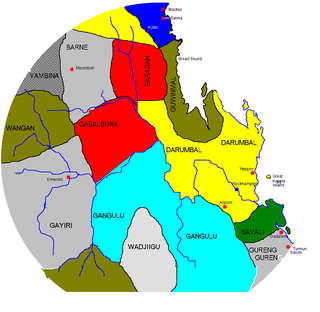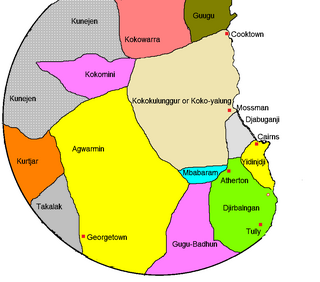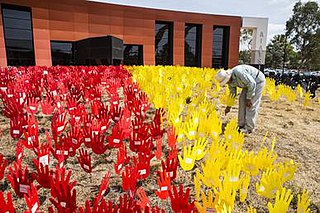Country
In Norman Tindale's estimation the Ewamin had approximately 5,700 square miles (15,000 km2) of tribal land, centering on the headwaters of the Einasleigh and Copperfield rivers. Their northern limits reached as far as Georgetown, Mount Surprise, and Lancewood. Their eastern boundaries lay up around the Great Dividing Range, while their western reaches touched the headwaters of the Percy River. They were present at the contemporary sites oft Oak Park, Einasleigh, Queensland Einasleigh and Forsayth.

Norman Barnett Tindale AO was an Australian anthropologist, archaeologist, entomologist and ethnologist.

The Einasleigh River is a river located in Far North Queensland, Australia. When combined with the Gilbert River, the river system is the largest river system in northern Australia.

Georgetown is a town and locality in the Shire of Etheridge, Queensland, Australia. In the 2011 census, Georgetown had a population of 243 people.
The Mbabaram lay directly north of the Ewamin. In clockwise direction, their eastern neighbours where the Warungu, and the Gugu-Badhun, and, south-east, the Gudjal. On their southern flank were the
Mbabaram or Mbabaram, often referred to as the Barbaram people, are an Indigenous Australian people living in Queensland on the rainforests of the Atherton Tableland.
The Warruŋu, also known as the Warungu/Warrongo, were an Indigenous Australian people of the northern Queensland rainforest areas south of Cairns.

The Gugu Badhun are an Aboriginal nation whose country is located in the Upper Burdekin region of northern Queensland. Gugu Badhun country is approximately 220km northwest of Townsville and includes the small township of Greenvale as well as a number of pastoral stations. The most comprehensive and up-to-date description of the nation is found in the book Gugu Badhun: People of the Valley of Lagoons, published in 2017.
This page is based on this
Wikipedia article Text is available under the
CC BY-SA 4.0 license; additional terms may apply.
Images, videos and audio are available under their respective licenses.

The Gudjal, also known as the Kutjala, are an indigenous Australian people of northern Queensland. They are not to be confused with the Kutjal.

The Kabalbara also rendered Gabalbura and Gabulbarra, is an Australian aboriginal tribe of northern Queensland. No linguistic information has been recorded.
The Goeng or Goeng Goeng were an indigenous Australian tribe of the state of Queensland. They lived in the area of the area of present day Gladstone.
The Walmbaria are an indigenous Australian people of Cape York Peninsula in northern Queensland.
The Matuntara are an indigenous Australian people of the Northern Territory.
The Kokobididji were an indigenous Australian people of the state of Queensland.
The Kokobujundji were an indigenous Australian people of the state of Queensland.
The Gugu Rarmul were an indigenous Australian people of the state of Queensland, one of several whose speech was called Gugu Yawa.
The Laia were an indigenous Australian people of the state of Queensland.
The Wiknatanja were an indigenous Australian people, one of the Wik tribes of the Cape York Peninsula of northern Queensland.
The Wik Paach or Wikapatja were an indigenous Australian people of the Cape York Peninsula of northern Queensland.
The Wikatinda were an indigenous Australian people of the Cape York Peninsula of northern Queensland. They were one of the Wik peoples, but their language is unattested.
The Wik Elken (Wik-Kalkan), or Wik-Ngatharr, were an indigenous Australian people, one of the Wik tribes of the Cape York Peninsula of the state of Queensland.
The Wakaman(Tindale) otherwise spelt Wagaman are an Indigenous Australian people of the state of Queensland. According to some authorities, they may be interchangeable with the group identified by ethnographers as the Ewamin.
The Yilba, also written Ilba, were an indigenous Australian people of the state of Queensland.
The Yangaa were an indigenous Australian people of the state of Queensland. They may be the same as the Nyangga. They are not to be confused with the Yangga.
The Kulumali were an indigenous Australian people of the state of Queensland.
The Kongabula were an indigenous Australian people of the state of Queensland.










